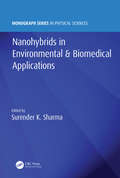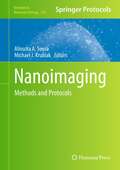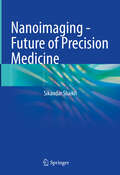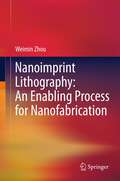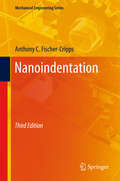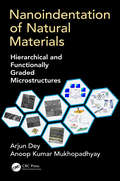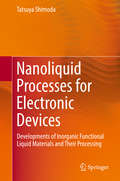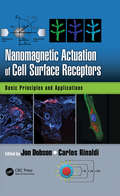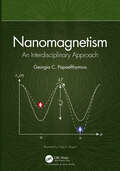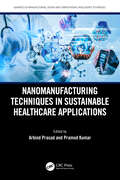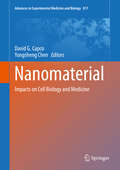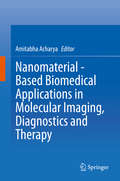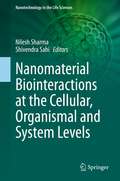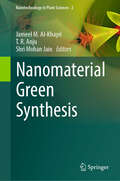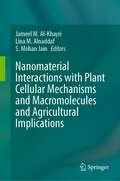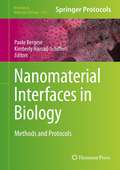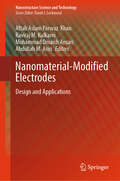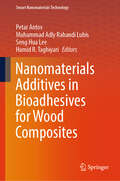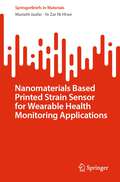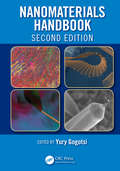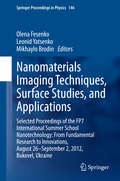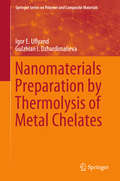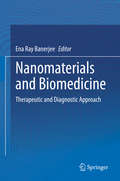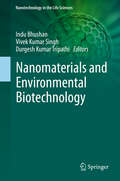- Table View
- List View
Nanohybrids in Environmental & Biomedical Applications (Monograph Series in Physical Sciences)
by Surender Kumar SharmaHeterostructured nanoparticles have the capability for a broad range of novel and enhanced properties, which leads to appealing biomedical and environmental applications. This timely new book addresses the design and preparation of multiphase nanomaterials with desired size, shape, phase composition, and crystallinity, as well as their current applications. It emphasizes key examples to motivate deeper studies, including nanomaterial-based hyperthermia treatment of cancer, nanohybrids for water purification, nanostructures used in the removal or detection of bioagents from waste water, and so on. Features Presents state of the art research on heterostructured nanomaterials, from their synthesis and physiochemical properties to current environmental and biological applications. Includes details on toxicity and risk assessment of multifunctional nanomaterials. Discusses recent developments and utilization in healthcare by leading experts. Introduces the main features of functionalization of nanomaterials in terms of desired size, shape, phase composition, surface functionalization/coating, toxicity, and geometry. Emphasizes practical applications in the environmental and biomedical sectors.
Nanoimaging
by Michael J. Kruhlak Alioscka A. SousaFor more than a century, microscopy has been a centerpiece of extraordinary discoveries in biology. Along the way, remarkable imaging tools have been developed allowing scientists to dissect the complexity of cellular processes at the nano length molecular scales. Nanoimaging: Methods and Protocols presents a diverse collection of microscopy techniques and methodologies that provides guidance to successfully image cellular molecular complexes at nanometer spatial resolution. The book's four parts cover: (1) light microscopy techniques with a special emphasis on methods that go beyond the classic diffraction-limited imaging; (2) electron microscopy techniques for high-resolution imaging of molecules, cells and tissues, in both two and three dimensions; (3) scanning probe microscopy techniques for imaging and probing macromolecular complexes and membrane surface topography; and (4) complementary techniques on correlative microscopy, soft x-ray tomography and secondary ion mass spectrometry imaging. Written in the successful format of the Methods in Molecular BiologyTM series, chapters include introductions to their respective topics, lists of the necessary materials and reagents, step-by-step protocols, and notes on troubleshooting and avoiding known pitfalls. Authoritative and accessible, Nanoimaging: Methods and Protocols highlights many of the most exciting possibilities in microscopy for the investigation of biological structures at the nano length molecular scales.
Nanoimaging - Future of Precision Medicine
by Sikandar ShaikhThe book covers all the aspects of the advances in nanoimaging. It provides a step-by-step overview of the various aspects of nanoimaging from the basics like nanoparticle production. It describes the different applications of nanoparticles across multiple imaging modalities and their applications in oncology, cardiology, neurology, infection and inflammation and many other conditions. The book also covers the detailed use of the different modalities like ultrasound, CT, MRI, PET-CT, PET-MRI, and nuclear medicine for various conditions. It describes various nanoparticles, nano biomarkers and nanoprobes used for multiple applications. Several chapters provide detailed information on the molecular level. Additionally, the book discusses nano theranostics - a newer concept used in molecular imaging for diagnosing the disease and its therapeutic purpose. It provides basic and detailed information on the use of nanoimaging in various conditions and pathologies along with therapeutic options. The book is helpful for residents, fellows, students and various specialists, such as radiologists, molecular imaging specialists, molecular biologists, oncologists, hematologists, surgeons, biomedical engineers, and various specialities involving the use of nanoimaging.
Nanoimprint Lithography: An Enabling Process for Nanofabrication
by Weimin ZhouNanoimprint Lithography: An enabling process for nanofabrication presents a comprehensive description of nanotechnology that is one of the most promising low-cost, high-throughput technologies for manufacturing nanostructures, and an emerging lithography candidates for 22, 16 and 11 nm nodes. It provides the exciting, multidisciplinary field, offering a wide range of topics covering: principles, process, material and application. This book would be of specific interest for researchers and graduate students in the field of nanoscience, nanotechnology and nanofabrication, material, physical, chemical, electric engineering and biology. Dr. Weimin Zhou is an associate professor at Shanghai Nanotechnology Promotion Center, China.
Nanoindentation
by Anthony C. Fischer-CrippsNanoindentation, Third Edition gives a detailed account of the most up-to-date research in this important field of materials testing. As in previous editions, extensive theoretical treatments are provided and explained in a clear and consistent manner that will satisfy both experienced and novice scientists and engineers. Additionally, numerous examples of the applications of the technique are provided directly from manufacturers of nanoindentation instruments. A helpful series of appendices provides essential reference information that includes a list of frequently asked questions. The new edition has been restructured to provide results of the latest research and developments in the field of mechanical testing while retaining the essential background and introductory, but authoritative nature, of the previous editions. The new edition also expands on the instrumentation and applications chapters by including material sourced direct from the instrument manufacturers in this field. Aimed at graduate student level, this book is designed to fill a need associated with the use of nanoindentation as a quantitative test method for mechanical properties of small volumes of materials.
Nanoindentation of Natural Materials: Hierarchical and Functionally Graded Microstructures
by Arjun Dey Anoop Kumar MukhopadhyayNanoindentation of Natural Materials: Hierarchical and Functionally Graded Microstructures provides a systematic introduction and review of state-of-the-art statistical hierarchical and functionally graded structures found in bone, teeth, hair, and scales, from a nanoindentation perspective, including detailed microstructure and composition. It covers the basics of hierarchical and functionally graded structures and nanoindentation techniques and detailed discussion with correlation micro/nano mechanical-structures The book includes practical issues backed with experimental data
Nanoliquid Processes for Electronic Devices: Developments of Inorganic Functional Liquid Materials and Their Processing
by Tatsuya ShimodaThis book summarizes the results of the research on how to make small electronic devices with high properties by using simple liquid processes such as coating, self-assembling and printing, especially focusing on devices composed of silicon and oxide materials. It describes syntheses and analyses of solution materials, formations of solid thin films from solutions, newly developed patterning methods to make devices, and characterization of the developed devices. In the first part of the book, the research on liquid silicon (Si) materials is described. Because the use of a liquid material is a quite new idea for Si devices, this book is the first one to describe liquid Si materials for electronic devices. Si devices as typified by MOS-FET have been produced by using solid and gas materials. This volume precisely describes a series of processes from material synthesis to device fabrication for those who are interested and are/will be engaged in liquid Si-related work. In the latter part of the book, a general method of how to make good oxide films from solutions and a new imprinting method to make nanosized patterns are introduced. For making oxide films with high quality, the designing of the solution is crucial. If a solution is designed properly, a gel material called "cluster gel" can be formed which is able to be imprinted to form nanosized patterns. The anticipated readers of this book are researchers, engineers, and students who are interested in solution and printing processes for making devices. More generally, this book will also provide guidelines for corporate managers and executives who are responsible for making strategies for future manufacturing processes.
Nanomagnetic Actuation in Biomedicine: Basic Principles and Applications
by Jon Dobson Carlos RinaldiThe manipulation and control of cells and sub-cellular structures through magnetic nanoparticle-based actuation is a relatively new technique that has led to novel and exciting biomedical applications. Nanomagnetic actuation is being used in laboratory studies of stem cells to determine how these mechanical cues can be used to control stem cell differentiation for regenerative medicine applications. This book explores this rapidly expanding field. It will interest industry bioscientists and biomedical engineers as well as academics in cellular biomechanics, cell and tissue engineering, and regenerative medicine. Key Features Focuses on the fundamentals and applications of magnetic actuation Includes contributions by world-class researchers from several countries and is edited by a well-known researcher in this field Offers multidisciplinary coverage and applications Supplies extensive references at the end of each chapter
Nanomagnetism: An Interdisciplinary Approach
by Georgia C. PapaefthymiouNanomagnetism: An Interdisciplinary Approach provides a core foundation for understanding magnetic quantum-size effects at the nanoscale and their many applications across the disciplines. This textbook will be a valuable guide for students in new interdisciplinary courses in nanomagnetism and magnetic nanomaterials, an area that has experienced immense growth in the last two decades due to advancements in sample preparation, nanopatterning techniques and magnetic measurement instrumentation. The interdisciplinary nature of nanoscience also makes this book an ideal resource for scientists working in industrial laboratories and pharmaceutical and medical researchers looking to expand their understanding of the physics of magnetic probes. Key Features Discusses physical, chemical and nanotemplating synthesis techniques for the production of magnetic nanoparticles Covers experimental techniques for the determination of the macroscopic and microscopic magnetization of nanoparticles Discusses the role of nanomagnetism in high-density magnetic recording media, nanostructured permanent magnets, MRI imaging enhancement and magnetically guided drug delivery
Nanomagnets as Dynamical Systems: Physics and Applications (Nanostructure Science and Technology)
by Supriyo Bandyopadhyay Anjan BarmanThis contributed volume provides a comprehensive overview of contemporary advancements in the field of nanomagnetism and spintronics. It covers a diverse range of topics, including the static and dynamic responses of designer nanomagnets, spin wave dynamics in ultra-thin ferromagnetic films, voltage-controlled magnetic anisotropy, magneto-elastic control of nanomagnet dynamics, mutual synchronization in spintronic oscillators, magnetic droplet solitons, and the applications of voltage-controlled magnetic anisotropy in spintronic devices. Each chapter discusses specific aspects of these subjects, exploring theoretical models, experimental methods, applications, and future directions, making it an essential resource for researchers, students, and professionals in the fields of physics, materials science, electrical engineering and nanonscience.
Nanomanufacturing Techniques in Sustainable Healthcare Applications (Advances in Manufacturing, Design and Computational Intelligence Techniques)
by Arbind Prasad and Pramod KumarThe text begins by discussing the processing and characterization of nano-manufactured resorbable bionanocomposites and presents the latest advances in carbon-based polymer nanocomposite materials for sensing applications. It further presents different characterization techniques such as scanning electron, transmission electron, atomic force microscopy, and powder X-ray diffraction for the identification of bionanocomposites.This book:• Introduces nano-manufactured processed composites for biomedical application, processing, and characterization of bionanocomposites.• Presents biobased nano-manufactured processed composites for imaging, tissue repairing, and drug-delivery applications.• Explains future trends of nano-manufactured composites in 3D bio-implants and fluorescent bioimaging.• Highlights the challenges and perspectives of polymeric nano-manufactured composites for biomedical applications.• Covers multifunctional nano-manufactured bio-composites, and advances in polymeric membranes for healthcare applications.It is primarily written for senior undergraduates, graduate students, and academic researchers in the fields of manufacturing engineering, biomedical engineering, materials science and engineering, mechanical engineering, and production engineering.
Nanomaterial
by David G. Capco Yongsheng ChenThe rapidly developing field of nanomaterials has expanded in many commercial areas. More recent studies have begun to provide a foundation for understanding how nanomaterials influence cells and how they also can serve as methodological tools for studies in medicine and cell biology, including research into stem cells. Recent investigations have shown affects of nanomaterials on specific subcellular structures, such as the actin-based brush border network in cells with an increasing emphasis on the barrier function of epithelial tissues. While other studies have shown involvement of nanoparticles in specific cytoplasmic signal transduction events such as the rise in intracellular free calcium, a signaling event known to regulate many changes in cell architecture and function. In parallel, nanomaterials are increasingly used in medicine for drug delivery, treatment of cancer and an increasing number of new applications. This book investigates these areas and also includes new methods for assessment in cell biology and medicine.
Nanomaterial - Based Biomedical Applications in Molecular Imaging, Diagnostics and Therapy
by Amitabha AcharyaThis book comprehensively reviews the recent advances in nanomaterial-based molecular imaging, diagnostics, and personalized therapy. It discusses the novel biocompatible fluorescent nanomaterials, their synthesis, and modern state of art characterization, as well as the various strategies for immobilization of biomacromolecules on the nanomaterial surface and approaches for increasing their stability. In addition, the book describes the synthesis of lectin nanoconjugates using different types of biocompatible raw materials and their systematic characterization. Lastly, it presents our current understanding of the biomolecular carona, which affects nanoparticle-based targeted drug delivery, and examines the conceptual approaches to improve the in-vivo efficacy of targeted drug delivery.
Nanomaterial Biointeractions at the Cellular, Organismal and System Levels (Nanotechnology in the Life Sciences)
by Nilesh Sharma Shivendra SahiThe range of nanomaterial applications has expanded recently from catalysis, electronics, and filtration to therapeutics, diagnostics, agriculture, and food because of unique properties and potentials of different nanoparticles and nanomaterials. Research shows that these exquisite particles can interact with an organism at the cellular, physiological, biochemical, and molecular levels. However, our knowledge of how they affect these changes, selectively or generally, in diverse organism or ecosystems is very limited and far from satisfactory. Data indicate that the biological function largely depends on the shape, size, and surface characteristics of the nanoparticles used besides life cycle stages of an organism. Therefore, this compilation will focus on the body of work carried out by distinguished investigators using diverse nanomaterials and plant and animal species. This book includes specific case studies as well as general review articles highlighting aspects of multilayered interactions, and targets not only research and academic scholars but also the concerned industry and policy makers as well.
Nanomaterial Green Synthesis (Nanotechnology in Plant Sciences #2)
by Shri Mohan Jain Jameel M. Al-Khayri T. R. AnjuThis book discusses the convergence between nanotechnology and sustainability detailing the advances in addressing global challenges in achieving technological advancement in nanoscience. It delves into eco-friendly advancements in agricultural nanotechnology, highlighting the transformative potential and challenges. The core of the book emphasizes green chemistry approaches, detailing the biological routes for synthesizing nanomaterials, alongside non-biological methods that minimize environmental impact. It investigates the biocompatibility of green nanomaterials for safer applications and assesses their recyclability and reusability. Chapters on life cycle assessment provide insights into the environmental footprints of nanomaterials. The book contrasts top-down and bottom-up approaches while comparing chemical and green synthesis. Special attention is given to nanomaterials derived from lignocellulosic biomass, underlining the role of waste valorization. In addition, it offers a critical analysis of challenges and perspectives in green nanotechnology, setting a roadmap for sustainable advancements. The book consists of 18 chapters that explore various aspects of green synthesis of nanomaterials. Chapters are contributed by 64 recognized scientists from 7 countries and subjected to a rigorous review process to ensure quality presentation and scientific precision. Chapters begin with an introduction providing background followed by a detailed discussion of the topic accompanied by 129 high-quality color figures and 24 tables. Each chapter concludes with recommendations for future study directions. The book is an excellent reference source for graduate students engaged in nanotechnology and for professional researchers working on translational research on nanomaterial biological and physiochemical aspects.
Nanomaterial Interactions with Plant Cellular Mechanisms and Macromolecules and Agricultural Implications
by S. Mohan Jain Jameel M. Al-Khayri Lina M. AlnaddafThis book focuses on the recent progress of nanotechnology with emphasis on the interaction between nanoparticles and plants on the cellular level. It is devoted to understanding the pathways of nanomaterials entry into plant cell and their influence on cellular organelle processes and influence on crop yield. It consists of 16 chapters grouped in 3 parts: Part I Cellular mechanisms, Part II Cellular macromolecules, and Part III Implications of nanomaterials. Chapters present the plant response to nanomaterial applications including morphological, physiochemical, and anatomical changes and their effect on plant growth and productivity. The book discusses the mechanisms of absorbance and translocation of nanoparticles and their interaction with the plant cellular biochemical compounds and organelles. It presents the current perspective of nanomaterials influence on cellular processes which include photosynthesis, photorespiration and pigment synthesis and accumulation. In addition, it provides current understanding of the impact of nanomaterials on cellular macromolecules including carbohydrates, lipids, nucleic acids, proteins, hormones, and antioxidant defense activities. Collectively, these processes and biochemical compounds have implications on crop yield. Chapters are written by globally recognized scientists and subjected to a rigorous review process to ensure quality presentation and scientific precision. Chapter begins with an introduction that covers similar contexts and includes a detailed discussion of the topic accompanied by high-quality color images, diagrams, and relevant details and concludes with recommendations for future study directions.Chapter "Impact of Nanomaterials on Plant Secondary Metabolism" is available open access under a Creative Commons Attribution 4.0 International License via link.springer.com.
Nanomaterial Interfaces in Biology: Methods and Protocols
by Kimberly Hamad-Schifferli Paolo BergeseThe intersection of nanotechnology with biology has given rise to numerous ideas for new ways to use nanotechnology for biological applications. Nanomaterials possess unique size- and material-dependent properties which make them attractive for improving regular biomedical fields, such as drug delivery, imaging, therapy, and diagnostics. Divided into three convenient sections, Nanomaterial Interfaces in Biology: Methods and Protocols covers protocols describing synthesis, fabrication, and construction of bio-nanomaterial interfaces, characterization protocols of bio-nanomaterial interfaces, and applications which utilize the bio-nanomaterial interfaces. Written in the highly successful Methods in Molecular Biology series format, chapters contain introductions to their respective topics, lists of the necessary materials and reagents, step-by-step, readily reproducible laboratory protocols, and notes on troubleshooting and avoiding known pitfalls. Authoritative and accessible Nanomaterial Interfaces in Biology: Methods and Protocols will serve the new and emerging scientific community, enabling new capabilities and technologies that were not previously possible in medicine and biology.
Nanomaterial-Modified Electrodes: Design and Applications (Nanostructure Science and Technology)
by Abdullah M. Asiri Mohammad Omaish Ansari Aftab Aslam Parwaz Khan Raviraj M. KulkarniThis contributed volume overviews the latest developments in the area of nanomaterial-modified electrodes and presents their unique biosensing, pharmaceutical and environmental applications. The book provides a comprehensive introduction on the basics of electrochemical sensors while also presenting overviews of multiple modified electrodes as essential elements for the development of sensors. The principle electrochemical sensors which are transducing the chemical/biochemical reactions to electrical signals are presented, while a special focus on lab-on-chips as well as the design and applications of various flexible electrodes is given. This book is of great benefit to researchers, graduate students and professionals working in the areas of biosensing, materials science, environmental engineering and pharmaceutical analysis.
Nanomaterials Additives in Bioadhesives for Wood Composites (Smart Nanomaterials Technology)
by Hamid R. Taghiyari Seng Hua Lee Petar Antov Muhammad Adly Rahandi LubisThis book presents an overview of recent developments in the use of nanomaterials, such as nanocellulose, nanolignin, and nanoclay, in the synthesis of sustainable, bio-based adhesives for manufacturing high-performance, eco-friendly wood-based composites with enhanced properties, close-to-zero formaldehyde emission, and a lower environmental footprint for advanced value-added applications. In recent years, bio-based wood adhesives have received great attention as a sustainable alternative to the conventional synthetic adhesives used in the wood-based industry. However, bioadhesives based on natural and renewable feedstocks, such as protein, starch, lignin, and tannin, have inferior properties compared to thermosetting synthetic resins. Reinforcement with nanomaterials with a high aspect ratio has the potential to improve the performance of bio-based wood adhesives and the technological properties of wood composites. The book explores the present-day challenges and future prospects of using nanomaterials in bio-based wood adhesives. The content of this book appeals to materials scientists, wood scientists, environmental scientists, and wood-based panel industry professionals.
Nanomaterials Based Printed Strain Sensor for Wearable Health Monitoring Applications (SpringerBriefs in Materials)
by Mariatti Jaafar Ye Zar Ni HtweThis book reviews different types of nanomaterials-based-conductive inks used to develop printed strain sensors, printing fabrication methods, and applications such as wearable health monitoring. Printed wearable electronic devices have recently drawn a lot of attention, as shown by the increasing number of publications and commercialized devices covering various facets in emerging fields. Many researchers are working toward optimizing nanoparticle-based-conductive inks for wearable electronics. However, issues related to its stability, dispersion, and annealing temperature often limit its applications. General important information and requirements of flexible electronics for health monitoring are covered in the book chapter. The target audiences are researchers and students who are involved in the development of printed wearable electronics.
Nanomaterials Handbook (Advanced Materials and Technologies)
by Yury GogotsiThis title features 11 new chapters unique to this edition, including chapters on grain boundaries in graphene, 2D metal carbides and carbonitrides, mechanics of carbon nanotubes and nanomaterials, biomedical applications, oxidation and purification of carbon nanostructures, sintering of nanoceramics, hydrothermal processing, nanofibers, and nanomaterials safety. It offers a comprehensive approach with a focus on inorganic and carbon-based nanomaterials, including fundamentals, applications, synthesis, and characterization. This book also provides a unique angle from the nanomaterial point of view on application, synthesis, and characterization not found in any other nanomaterials book on the market.
Nanomaterials Imaging Techniques, Surface Studies, and Applications: From Fundamental Research to Innovations, August 26-September 2, 2012, Bukovel, Ukraine
by Leonid Yatsenko Mikhaylo Brodin Olena FesenkoThis book presents cutting-edge research on a wide range of nanotechnology techniques and applications. It features contributions from scientists who participated in the International Summer School "Nanotechnology: From Fundamental Research to Innovations" in Bukovel, Ukraine on August 26 - September 2, 2012 funded by the European Commission FP7 project Nanotwinning implemented by the Institute of Physics of National Academy of Sciences of Ukraine and partner institutions: University of Tartu (Estonia), European Profiles A.E. (Greece), University of Turin (Italy) and Université Pierre et Marie Curie (France). Worldwide experts present the latest results on such key topics as microscopy of nanostructures; nanocomposites; nanostructured interfaces and surfaces; nanooptics; nanoplasmonics; and enhanced vibrational spectroscopy. Imaging technique coverage ranges from atomic force microscopy and spectroscopy, multiphoton imagery, and laser diagnostics of nanomaterials and nanostructures, to resonance Raman and SERS for surface characterization, and scanning tunneling microscopy of organic molecules. The breadth of topics highlights the exciting variety of research currently being undertaken in this field and suggests new opportunities for interdisciplinary collaboration and future research.
Nanomaterials Preparation by Thermolysis of Metal Chelates (Springer Series on Polymer and Composite Materials)
by Gulzhian I. Dzhardimalieva Igor E. UflyandThe book focuses on the thermal transformations of various types of metal chelates, e.g. low molecular weight and polymeric metal chelates, coordination polymers and metal-organic frameworks. It analyzes the major advances and the problems in the preparation of metal oxide materials, mixed-oxide nanocomposites, carbon materials and polymer derived non-oxide nanocomposites by the thermolysis of different metal chelates. It also highlights the influence of the spatial and electronic structure of metal chelates on the mechanism and kinetics of their thermal transformations, and discusses important issues like conjugate thermolysis and computer modelling of the thermolysis process. This book is useful for researchers experienced in thermolysis as well as for young scientists interested in this area of science.
Nanomaterials and Biomedicine: Therapeutic and Diagnostic Approach
by Ena Ray BanerjeeThis book comprehensively reviews the history of nanotechnology, and describes the physiochemical properties of various nanoparticles and their biomedical applications. Covering the biotoxicity of nanoparticles, their bio-distribution and release kinetics, and their role in diagnosis, pre-clinical drug discovery and disease prevention, it also examines the application of nanoscaffolds in tissue engineering and as cell culture templates. Further, the book discusses several fabrication methodologies for regenerative medicine, and explores nanotechnology-based stem cell therapeutics, including stem cell transfection, stem cell delivery, and stem cell expansion for promoting tissue regeneration. Lastly, it addresses the use of DNA barcoding technology from nanosamples for the detection, identification and validation of emerging pathogens, biodiversity and ancient remnants of living specimens, and highlights various strategies for the plant-mediated synthesis of nanoparticles. Given its scope, it is a valuable reference resource for graduate students and researchers interested in understanding the diverse range of biomedical applications of nanoparticles.
Nanomaterials and Environmental Biotechnology (Nanotechnology in the Life Sciences)
by Vivek Kumar Singh Durgesh Kumar Tripathi Indu BhushanNanotechnology is considered as one of the emerging fields of science. It has applications in different biological and technological fields which deal with the science of materials at nanoscale (10-9). On the other hand, biotechnology is another field that deals with contemporary challenges. Nanobiotechnology fills the gap between these two fields. It merges physical, chemical, and biological principles in a single realm. This combination opens up new possibilities. At nanoscale dimensions, it creates precise nanocrystals and nanoshells. Integrated nanomaterials are used with modified surface layers for compatibility with living systems, improved dissolution in water, or biorecognition leading to enhanced end results in biotechnological systems. These nanoparticles can also be hybridized with additional biocompatible substances in order to amend their qualities to inculcate novel utilities. Nanobiotechnology is used in bioconjugate chemistry by coalescing up the functionality of non-organically obtained molecular components and biological molecules in order to veil the immunogenic moieties for targeted drug delivery, bioimaging and biosensing. This book blends the science of biology, medicine, bioinorganic chemistry, bioorganic chemistry, material and physical sciences, biomedical engineering, electrical, mechanical, and chemical science to present a comprehensive range of advancements. The development of nano-based materials has made for a greater understanding of their characterization, using techniques such as transmission electron microscope, FTIR, X-ray diffraction, scanning electron microscope EDX, and so on. This volume also highlights uses in environmental remediation, environmental biosensors and environmental protection. It also emphasizes the significance of nanobiotechnology to a series of medical applications viz., diagnostics, and therapeutics stem cell technology, tissue engineering enzyme engineering, drug development and delivery. In addition this book also offers a distinctive understanding of nanobiotechnology from researchers and educators and gives a comprehensive facility for future developments and current applications of nanobiotechnology.
